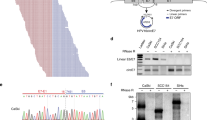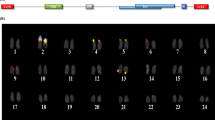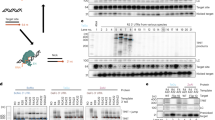Abstract
The integrated DNA copies (proviruses) of RNA tumour virus genomes are flanked by long terminal repeat (LTR) sequences, which are generated by the duplication of segments present at both ends of the viral RNA1. LTRs vary in length from 330 (ref. 2) to 1,328 (this paper) base pairs (bp). The primary viral transcript starts in the left LTR (L-LTR) and terminates in the right LTR (R-LTR)3. We have now sequenced both LTRs from an inherited (endogenous) mouse mammary tumour virus (MMTV) of the GR strain. This provirus, which is one of five present in the haploid genome of GR mice4, does not produce virus5 and is not identical with the exogenous MMTV of GR mice6. The provirus (GR40) could nevertheless be transcribed and its transcription hormonally regulated after cloning and transfection into mouse L cells7. The LTRs are identical and exhibit the following features: a terminal inverted 6-bp repeat, a Goldberg–Hogness (TATAAA) sequence, sequences which have been implicated in polyadenylation and the termination of transcription, and an open reading frame. The open reading frame of the R-LTR starts at the env/LTR junction and encodes a 36,700-molecular weight (Mr) protein. The open reading frame of the L-LTR extends into the adjacent mouse sequence. A host sequence of 6 bp at the site of integration into the mouse chromosome is directly repeated.
This is a preview of subscription content, access via your institution
Access options
Subscribe to this journal
Receive 51 print issues and online access
$199.00 per year
only $3.90 per issue
Buy this article
- Purchase on Springer Link
- Instant access to full article PDF
Prices may be subject to local taxes which are calculated during checkout
Similar content being viewed by others
References
Gilboa, E. Mitra, S. W. Goff, S. & Baltimore, D. Cell 18, 93–100 (1979).
Swanstrom, R. DeLorbe, W. J. Bishop, J. M. & Varmus, H. E. Proc. natn. Acad. Sci. U.S.A. 78, 124–128 (1981).
Yamamoto, T. de Crombrugghe, B. & Pastan, I. Cell 22, 789–797 (1980).
Groner, B. & Hynes, N. E. J. Virol. 33, 1013–1025 (1980).
Michalides, R. van Nie, R. Nusse, R. Hynes, N. E. & Groner, B. Cell 23, 165–173 (1981).
Herrlich, P. et al. Nucleic Acids Res. 9, 4981–4995 (1981).
Hynes, N. E. Kennedy, N. Rahmsdorf, U. & Groner, B. Proc. natn. Acad. Sci. U.S.A. 78, 2038–2042 (1981).
Frischauf, A. M. Garoff, H. & Lehrach, H. Nucleic Acids Res. 8, 5541–5549 (1980).
Maxam, A. L. & Gilbert, W. Meth. Enzym. 65, 499–559 (1980).
Messing, J. Crea, R. & Seeburg, P. Nucleic Acids Res. 9, 309–321 (1981).
Sanger, F. Nicklen, S. & Coulson, A. R. Proc. natn. Acad. Sci. U.S.A. 74, 5463–5467 (1977).
Majors, J. E. & Varmus, H. E. Nature 289, 253–258 (1981).
Donehower, L. A. Huang, A. L. & Hager, G. J. Virol. 37, 226–238 (1981).
Hishinuma, F. DeBona, P. J. Astin, S. & Skalka, A. M. Cell 23, 155–164 (1981).
Calos, M. P. & Miller, J. H. Cell 20, 579–595 (1980).
Ohtsubo, H. Ohmori, H. & Ohtsubo, E. Cold Spring Harb. Symp. quant. Biol. 43, 1269–1277 (1979).
Shimotohno, K. & Temin, H. M. Cold Spring Harb. Symp. quant. Biol. 45, 719–732 (1981).
McClements, W. L. Enquist, L. W. Oskarsson, M. Sullivan, M. & Vande Woude, G. F. J. Virol. 35, 488–497 (1980).
Shoemaker, C. et al. Cold Spring Harb. Symp. quant. Biol. 45, 711–717 (1981).
Czernilofsky, A. B. et al. Nucleic Acids Res. 8, 2967–2984 (1980).
Peters, G. & Glover, C. C. J. Virol. 35, 31–40 (1980).
Cohen, J. C. & Varmus, H. E. Nature 278, 418–423 (1979).
Cohen, J. C. Majors, J. E. & Varmus, H. E. J. Virol. 32, 483–496 (1979).
Benoist, C. O'Hare, K. Breathnach, R. & Chambon, P. Nucleic Acids Res. 8, 127–142 (1980).
Klemenz, R. Reinhardt, M. & Diggelmann, H. Molec. Biol. Rep. 7, 123–126 (1981).
Proudfoot, N. J. & Brownlee, G. G. Nature 252, 357–362 (1974).
Lai, E. C. et al. Cell 18, 829–842 (1979).
Donehower, L. A. Fleurdelys, B. & Hager, G. L. J. Virol. (in the press).
Dickson, C. & Peters, G. J. Virol. 37, 36–47 (1981).
Dickson, C. Smith, R. & Peters, G. Nature 291, 511–513 (1981).
Shank, R. S. Cohen, J. C. Varmus, H. E. Yamamoto, K. R. & Ringold, G. Proc. natn. Acad. Sci. U.S.A. 75, 2112–2116 (1978).
Author information
Authors and Affiliations
Rights and permissions
About this article
Cite this article
Kennedy, N., Knedlitschek, G., Groner, B. et al. Long terminal repeats of endogenous mouse mammary tumour virus contain a long open reading frame which extends into adjacent sequences. Nature 295, 622–624 (1982). https://doi.org/10.1038/295622a0
Received:
Accepted:
Issue Date:
DOI: https://doi.org/10.1038/295622a0
This article is cited by
-
Mouse mammary tumor virus (MMTV)-like DNA sequences in the breast tumors of father, mother, and daughter
Infectious Agents and Cancer (2008)
-
Identification of three human sequences with viral superantigen-specific primers
Mammalian Genome (1995)
-
Endogenous superantigen expression controlled by a novel promoter in the MMTV long terminal repeat
Nature (1993)
-
Identification of a second retrotransposon-related element in the genome of Physarum polycephalum
Current Genetics (1990)
Comments
By submitting a comment you agree to abide by our Terms and Community Guidelines. If you find something abusive or that does not comply with our terms or guidelines please flag it as inappropriate.



